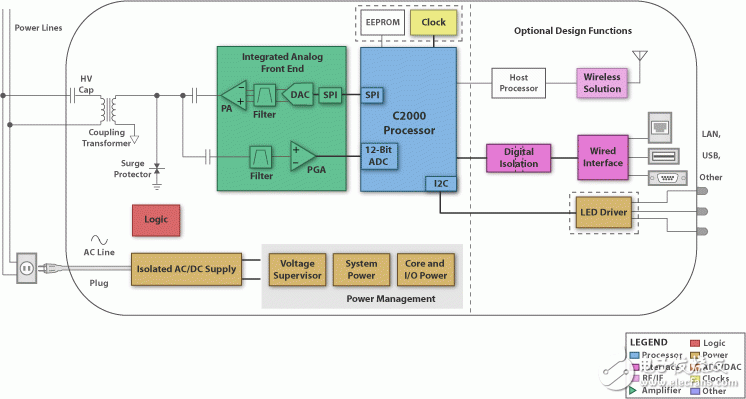Click on the color block to view/apply to order samples of the recommended solution.
Power Line Communications (PLC) leverages existing powerline infrastructure to provide a cost-effective approach to introducing intelligent monitoring and control in many industrial applications. It makes PLC one of the technology of choice for smart grid applications such as smart meter reading, lighting control, solar, plug-in electric vehicles, and heating, air conditioning and security systems in homes and buildings.
Implementing Low Frequency Narrowband PLC (LFNBPLC) technology for these applications will provide the most suitable bandwidth, power and cost requirements. Operating in a narrowband domain (up to 500kHz) ensures data integrity while minimizing system cost. Data rates range from 1.2 kbps to hundreds of kbps, depending on existing standards.
There are also difficulties in developing an efficient PLC implementation. Power lines are inherently noisy and require a robust architecture to ensure data reliability. In addition, each application and work environment is different, requiring developers to optimize the design for a variety of factors. Due to the wide variety of protocol standards and modulation schemes, developers need a flexible development platform that simplifies design, optimizes environmental conditions, and complies with local regulations while easily adapting to evolving standards.
The modulated signal of the power line communication modem system first enters the receiver stage or active bandpass filter, where the op amp selected for the filter should provide low noise, low harmonic distortion and low input bias (as in TI's OPA365 or OPA353) Shown). Wide dynamic range and optimized signal processing when adjusting the received signal using a programmable gain amplifier (PGA) such as the PGA112. It needs to be fast enough and accurately connected to the input of the analog-to-digital converter for proper conversion to digital form for processing. This is achieved with the on-chip 12-bit ADC of the F28235 DelfinoTM or F2802x/03x PiccoloTM microprocessors, which are members of the upgradeable C2000TM 32-bit microprocessor (MCU) family. The 12-bit ADC operates at up to 12.5 MSPS and includes a triggering mechanism to support multi-frequency and phase sampling (subsampling and hold). The C2000TM MCU family allows developers to support multiple modulations on the same hardware, eliminating the need to redesign the modem to support different modulations or standards. This makes the C2000TM 32-bit MCU family an intelligent and flexible platform for power line communication implementations.
The processed signal will be passed back to the grid by the PLC transmitter stage used to drive the high output current. The C2000ePWM can be controlled with duty cycle resolution down to 150ps for more harmonic control and reduced sample output delay. The transmitter stage must be carefully designed to receive digital signals from the MCU, filter these signals to eliminate band emission and drive low impedance of the AC power line. The OPA564 is a 24V, 1.5A, 17MHz power op amp that meets the stringent requirements of PLC line drivers. Combining the AFE031 (a highly integrated PLC analog front end) with the C20000TM further improves integration, performance and cost. The AFE031 integrates the transmit filter, power amplifier, receive filter and PGA into a programmable IC designed for PLCs.
The resulting modem MCU+AFE can communicate directly with external systems (wired and wireless applications) via one of the C2000TM serial interface options including CAN, I2C, LIN, SPI or UART.
TIPLC software is provided through the plcSUITE library, allowing developers to support multiple modulations and standards in a unique design. Developers can implement the SFSKIEC61334, PRIME, and G3 standards, use FlexOFDM for custom OFDM implementations, and upgrade for future standards.
From a power management perspective, the PLC module can use the power supply of the existing system DC rail or directly use the main AC power supply for communication. If it is the main AC power supply, it needs to filter the 115V, 60Hz filter in the US (or 230V, 50Hz in Europe and Asia) and convert it to isolated DC power supply for MCU, AFE and various support components. The UCC28600 or UCC28610 Green Mode Reverse Controller is best suited for providing isolated 12V or 15V DC rails for direct use in power amplifiers and for connection to DCDC modules (such as PTH08080W) or buck converters (such as TPS54231) to provide low voltage (5V) PLC system rail. If a linear regulator (such as the TPS79533LDO) is added, a practical low-noise 3.3V rail can be provided by low-power components such as MCUs, PGAs, op amps, USB transceivers, and any other digital or analog components.

Withstand high voltage up to 750V (IEC/EN standard)
UL 94V-2 or UL 94V-0 flame retardant housing
Anti-falling screws
Optional wire protection
1~12 poles, dividable as requested
960 Series Terminal Blocks,Electrical Terminal Strips,Electronic Terminal Blocks,Nylon Terminal Block,ballast terminal blocks
Jiangmen Krealux Electrical Appliances Co.,Ltd. , https://www.krealux-online.com
